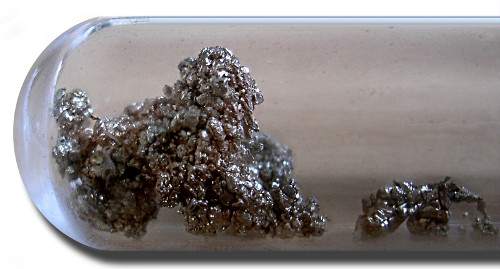Strontium commonly occurs in nature, averaging 0.034% of all igneous rock; only two minerals, celestite (strontium sulfate) and strontianite (strontium carbonate), however, contain strontium in sufficient quantities to make its recovery practical. Of the two, celestite occurs much more frequently in sedimentary deposits of sufficient size to make development of mining facilities attractive. Strontianite would be the more useful of the two common minerals because strontium is used most often in the carbonate form, but few deposits have been discovered that are suitable for development.
Why Is Strontium A Critical Raw Material?
Based on the USGS Mineral Commodity Summary, strontium qualifies as a critical raw material due to its complete import dependence and strategic importance. The United States has maintained a 100% net import reliance from 2020-2024, with no domestic production since large-scale manufacturing ceased in 2006. The U.S. imported approximately 100 metric tons of celestite and 4,000 metric tons of strontium compounds in 2024, primarily from Mexico (65%) and Germany (30%). This total dependence on foreign sources creates a significant supply chain vulnerability for a material essential to multiple industries.
The strategic importance of strontium is underscored by recent Defense Production Act investments. In February 2024, the Department of Defense selected companies in Louisiana and Ohio to establish domestic production of strontium nitrate, strontium oxalate, and strontium peroxide as part of a program to secure 22 critical chemicals. These compounds are vital for defense applications, particularly in pyrotechnics and signals, which account for 40% of U.S. strontium consumption. Another 40% goes to ceramic ferrite magnets used in electronics and industrial applications, while the remaining 20% serves specialized uses including electrolytic zinc production, glass manufacturing, and emerging technologies like ultra-precise atomic clocks.
The criticality of strontium is further reinforced by limited substitution options. While barium can replace strontium in ceramic ferrite magnets, it results in reduced maximum operating temperatures, compromising performance. In pyrotechnics, substitution is even more challenging due to the unique brilliance and visibility that strontium compounds provide. Despite global reserves exceeding 1 billion tons, with major deposits in China (12 million tons) and Iran (7.1 million tons), the lack of domestic production capability and the material’s essential role in defense and high-tech applications solidify strontium’s status as a critical raw material requiring strategic supply chain management.
20 Interesting Facts About Strontium?
- Strontium is an alkaline earth metal with atomic number 38 and symbol Sr, discovered in 1790 by Adair Crawford and William Cruickshank in the mineral strontianite near Strontian, Scotland.
- When burned, strontium compounds produce a brilliant crimson-red flame, making them essential for fireworks, flares, and pyrotechnics – this distinctive color comes from electrons transitioning between energy levels at specific wavelengths around 640-690 nanometers.
- Strontium-90, a radioactive isotope with a half-life of 28.8 years, is one of the most dangerous components of nuclear fallout because it mimics calcium and accumulates in bones and teeth.
- The element has four stable isotopes (Sr-84, Sr-86, Sr-87, and Sr-88), with Sr-88 being the most abundant at 82.58% of natural strontium.
- Strontium atomic clocks are among the most precise timekeeping devices ever created – in 2024, a strontium optical lattice clock achieved accuracy that would lose less than one second in 15 billion years.
- Natural strontium-containing minerals include celestite (SrSO₄), which contains 43.88% strontium, and strontianite (SrCO₃), which contains 59.35% strontium.
- Strontium has a melting point of 777°C (1,431°F) and a boiling point of 1,377°C (2,511°F), making it more reactive than calcium but less reactive than barium.
- In the human body, 99% of strontium is found in bones and teeth, where it can substitute for calcium in the hydroxyapatite crystal structure.
- Strontium ranelate was developed as a medication for osteoporosis treatment because it stimulates bone formation while reducing bone resorption.
- The element forms a dark oxide layer when exposed to air and reacts vigorously with water to produce strontium hydroxide and hydrogen gas.
- Strontium titanate (SrTiO₃) is a synthetic diamond simulant with a refractive index higher than diamond (2.41 vs 2.42) but lower hardness.
- In 2024, astronomers identified three of the universe’s oldest stars by detecting unusually low amounts of strontium and barium in their spectra.
- Strontium ions (Sr²⁺) have an ionic radius of 1.18 Ångströms, making them 13% larger than calcium ions, which affects their biological behavior.
- The element exhibits a face-centered cubic crystal structure at room temperature, transitioning to hexagonal close-packed at 235°C.
- Strontium ferrite (SrFe₁₂O₁₉) is a permanent magnetic material with a maximum operating temperature of 450°C, superior to barium ferrite alternatives.
- Natural strontium in seawater maintains a constant concentration of about 8 mg/L and serves as a proxy for ancient ocean chemistry in paleoceanography.
- The Sr-87/Sr-86 isotope ratio is used in archaeology and geology to trace the geographic origins of materials and human/animal migration patterns.
- Strontium aluminate doped with europium (SrAl₂O₄:Eu²⁺) creates the brightest and longest-lasting phosphorescent materials, glowing for hours after light exposure.
- The element has a density of 2.64 g/cm³, making it the lightest of the alkaline earth metals except for beryllium and magnesium.
- Strontium vapor is used in high-precision atomic physics experiments, including creating Bose-Einstein condensates and studying quantum phenomena at ultracold temperatures near absolute zero.
Thanks for reading!
